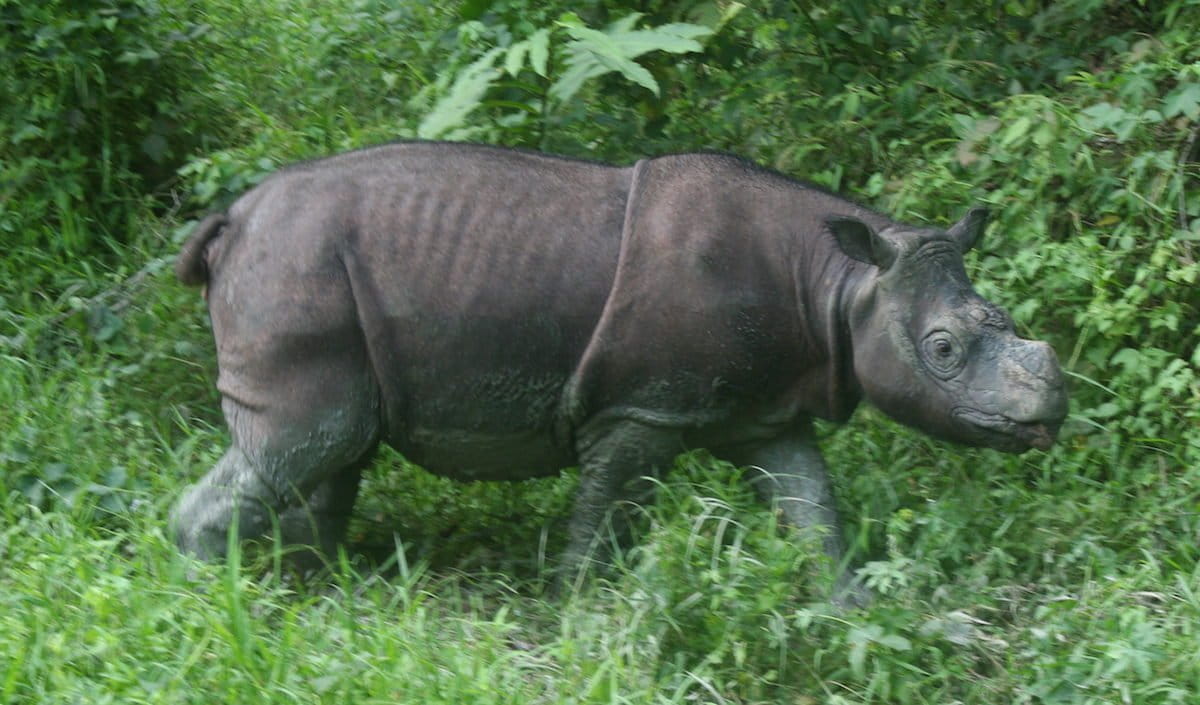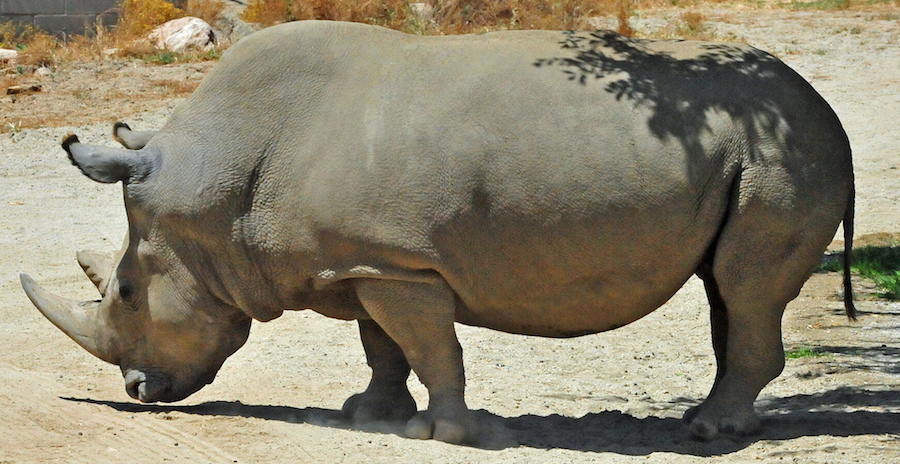- Bornean and northern white rhinos have little chance to avoid extinction without cutting-edge assisted reproductive technology.
- Conservation groups find it difficult to attract funding to develop these technologies, which are costly and not guaranteed to succeed.
- Organizations in Kenya and Malaysia have launched separate crowd-funding appeals to fund efforts to develop in vitro fertilization techniques.
- Both campaigns are far below targeted donation levels.
There’s probably only one thing left that can save the Bornean rhino (Dicerorhinus sumatrensis harrissoni): cutting-edge, high cost in vitro fertilization (IVF) technology. This subspecies of the Critically Endangered Sumatran rhino is represented by a dwindling handful of survivors in the wild – one of whom just perished when conservationists tried to move her this year – and three individuals living in captivity. The captive rhinos, one male and two females, are incapable of natural reproduction due to fertility problems. Extinction is on the horizon unless IVF is able to start producing rhino babies – and fast.
The technical difficulties are high – including the fact that IVF has never been successfully done with any of the world’s five rhino species – but the biggest hurdle may actually be something much more prosaic: money.
“Donors want to be assured that the animal will not go extinct on them in the next few years,” said John Payne, the executive director of the Borneo Rhino Alliance (BORA). “It is much safer to put money into a threatened species than it is to put money into a species that is on the edge of extinction.”

BORA provides a sanctuary for the three Bornean rhino; it covers the cost of feeding, protecting and caring for the trio. In addition, it’s been desperately trying – unsuccessfully to date – to use IVF to produce a rhino embryo. But BORA is nearly out of money. Payne says that by the end of the year, the group’s coffers will have run dry.
Until now, BORA had depended almost entirely on one donor for the past seven years: the Sime Darby Foundation, the charitable arm of the massive palm oil and rubber plantation giant. But this year the foundation announced it would be funding other projects.
“Without their financial support, the Sumatran rhino would have gone totally extinct in Malaysia by now,” said Payne. “The foundation still maintains a very close and genuine interest in what we are doing.”
Losing their financial support means BORA is left adrift. The group hopes to secure government funding for ongoing work with the rhinos, but it has also turned to another fundraising model. An admittedly crowded, competitive and fickle model: crowdfunding.
Strikingly similar
The situation facing the northern white rhino (Ceratotherium simum cottoni) is strikingly similar. Like the Bornean rhino there are only three northern white rhinos left in captivity and they are also incapable of having a baby rhino, forcing the groups working on this subspecies to also turn to expensive, unproven IVF. But unlike the Bornean, there are zero northern white rhinos left in the wild – all we have to work with is three captive animals.
“We do think [creating a rhino embryo] will happen, but it’s a question of when. The technology is not there yet and it’s a very complicated process,” Elodie Sampere, a spokesperson for the Ol Pejeta Conservancy said.
The Ol Pejeta Conservancy, located in Kenya, is home to the world’s final three northern white rhinos. It is working with the Dvur Králové Zoo in the Czech Republic to produce a rhino embryo that could then be carried by a different subspecies, the southern white rhino.
“The reality is that it could happen after all these rhinos have died,” Sampere said.

In a bid to produce a northern white rhino, even if the final three die beforehand, the team has stored sperm and hopes to soon have eggs. But all this depends on money, and IVF isn’t cheap.
Sampere argues that in an age of a potential mass extinction, developing IVF technologies is about more than just an individual species. “The technology…could help, in the future, restore many other species from extinction. It’s a very important project for the future of mammals all over the world.”
So far, though, the project has gained little traction with funders. “We have had some success at raising funds, but I think mostly people might be disillusioned about this project,” said Sampere.
Like BORA, the Ol Pejeta Conservancy has recently turned to crowdfunding in an attempt to raise funds for its bid to create rhino embryos.
Crowdfunding not a Holy Grail
On its page on crowdfunding site Generosity, BORA says it is attempting to raise nearly a million dollars “to stay operational for the next two years.” In two months, though, BORA has raised just $1,300, less than one percent of its $900,000 goal.
Ol Pejeta Conservancy has done little better. Its page on crowdfunding website GoFundMe has raised £22,890 of its £500,000 goal, around 4 percent of its target. However, it’s taken them 15 months to do this.
BORA set up its crowdfunding campaign in conjunction with the release of a new documentary highlighting their work called Operation Sumatran Rhino: Mission Critical aired on National Geographic. “The potential advantage is that not only do we hope to attract more funds, but that global awareness of the plight of this species is enhanced at the same time,” Payne said.
Ol Pejeta Conservancy kicked off its crowdfunding campaign when people approached them about how they could help following a series of articles on the northern white rhino. But Sampere admitted to date their campaign is “not that successful.”

Although it’s relatively straightforward for any organization to set up a campaign on a crowdfunding website like GoFundMe or Generosity, it’s notoriously difficult to be successful at it.
“The world we live in is noisier than ever before. Standing out and reaching new donors is the top challenge we hear from nonprofits doing crowdfunding,” said Rob Wu, head of CauseVox, a company that helps nonprofits raise money online.
Wu said that groups new at crowdfunding often make similar mistakes. These include assuming that there is already a built-in audience for the campaign, relying too heavily on social media as opposed to other ways of reaching supporters and neglecting storytelling.
Groups that fail “don’t tell their story in a way that is compelling and show potential supporters exactly why they should give,” Wu said.
He believes both rhino online campaigns suffer from “poor storytelling.”
“You can’t just put up a crowdfunding campaign, talk about a problem, and then expect people to donate. Sometimes it works, but most of the time, you’ll fall flat,” he said. Instead, he recommends groups focus on a specific character people can help, and carful target their campaigns. “Going niche will allow you to craft a story and message that really resonates.”
Crowdfunding presents an enticing way for struggling non-profits to raise money, but it requires a lot more time, effort and even money than is usually expected to achieve success. The same could be said for saving the world’s rhinos.
Neither Ol Pejeta Conservancy nor BORA is pinning all their hopes on crowdfunding. Ol Pejeta is raising funds from private donors and is also dependent on funds raised out of Dvur Králové Zoo. In an age when many conservation groups are moving away from endangered species programs, zoos and aquariums are a small, but rising, source of funds for saving species.

BORA is putting most of its hope on funding coming from the Malaysian government. As a very small organization, Payne said BORA has had little time for fundraising during the last few years.
“Until recently, we had not tried to seek financial support from sources outside Malaysia.”
Yet, even the best conservationists can’t save species without money. And the public can’t save species if they don’t fund the champions doing the day-to-day work.
The struggle for funding
There are few animals as endangered as the Bornean rhino and the northern white, so why is it so hard to raise money to save them?
“The ease with which funds can be raised for a particular species is not correlated at all with its degree of endangerment,” said Payne. “The biggest factor is how attractive the animal’s appearance and behavior is to humans.”
Payne is right. Research has shown that more attractive animals to people tend to get the most funding. Yet rhinos could hardly be called “uncharismatic.” According to Payne, Bornean rhinos get ignored due to being lumped in with the world’s other rhino subspecies and species. “It is like counting orangutans, gorillas, bonobos and chimpanzees as one thing.”
Given all the news out of South Africa of rhino poaching, Payne said that Sumatran rhinos get “left aside.”
Moreover, both the Bornean rhino and the northern white rhino face the subspecies problem: these two animals are not currently considered full species in their own right, diminishing them in the eyes of scientists and the public.

But recent research has suggested that the northern white rhino is actually a full species in its own right – having split from the southern white more than a million years ago. And the Bornean rhino may be key to survival of the Sumatran. At best, there are only 100 Sumatran rhinos left, surviving in a few unconnected populations. This means preserving the Bornean rhino – and its genetic diversity – is hugely important to saving the Sumatran rhino genus overall.
Funds have also been moving away from endangered species and more traditional conservation approaches for a number of decades, including many of the world’s biggest conservation groups tilting away from saving species towards more ecosystem service approaches.
Payne said the reality in conservation today is that “vague targets such as biodiversity, capacity building and ecosystems attract more interest than specific species.”
Wu added that groups fundraising for the environment or wildlife face an even higher hill to climb than human-focused groups. “When it comes to fundraising most people give to the people, not to animals.” This is borne out by data from Giving USA Annual Report, which tracks philanthropy in the U.S. According to the group, environment and wildlife organizations received just 3 percent of total giving in the U.S. last year.
Wu’s advice is to connect the animal back to humans in some way, either by focusing on a single animal and anthropomorphizing it or outlining on how the loss of the animal will impact a specific person or humanity in general.
“What you need to do is position the endangered species in a way that people can directly connect with,” he noted.
CITATIONS:
- Groves, Colin P., Prithiviraj Fernando, and Jan Robovský. “The sixth rhino: a taxonomic re-assessment of the critically endangered northern white rhinoceros.” PLoS One 5, no. 4 (2010): e9703.
- Martín-López, Berta, Carlos Montes, and Javier Benayas. “The non-economic motives behind the willingness to pay for biodiversity conservation.” Biological conservation 139, no. 1 (2007): 67-82.